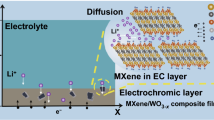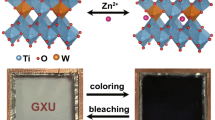Abstract
Electrochromic devices have many important commercial applications ranging from electronic paper like displays, antiglare rear-view mirrors in cars, to energy-saving smart windows in buildings. Monovalent ions such as H+, Li+, and Na+ are widely used as insertion ions in electrochromic devices, but they have limitations such as instability, high cost, and hard handling. The utilization of multivalent ions as insertion ions has been overlooked probably because of the strong electrostatic interactions between ions and intercalation framework as well as the resulted difficulties of intercalation.The bivalent cation, Mg2+, has been proved to be efficient electrochromic insertion ions for the electrochromic processes of the nonstoichiometric W18O49 nanowires. Using Mg2+ based aqueous electrolyte, the electrochromic W18O49 nanowires shows a short coloration/bleaching time of 2.7/3.6 s, and a high tinting productiveness of 116 cm2/c, together with excellent cyclic constancy. The utilization of bivalent Mg2+ as insertion ions will benefit electrochromic devices with low cost, high stability and simple operation.




Similar content being viewed by others
References
J.T. Wu, Y.Z. Fana, G.S. Liou, Synthesis, characterization and electrochromic properties of novel redox triarylamine-based aromatic polyethers with methoxy protecting groups. Polym. Chem. (2019). https://doi.org/10.1039/C8PY01308J
M. Pan, S. Zhao, L. Ma, N. Wu, D. Xiao, All-in-one electrochromic devices with biological tissues used as electronic components. Sol. Energy Mater. Sol. Cells 189, 27–32 (2019). https://doi.org/10.1016/j.solmat.2018.09.014
J. He, L. You, D. Tran, J.G. Mei, Low-temperature thermally-annealed niobium oxide thin films as a minimally color changing ion storage layer in solution-processed polymer electrochromic devices. ACS Appl. Mater. Interfaces. (2019). https://doi.org/10.1021/acsami.8b16154
G.Y. Karaca, E. Eren, G.C. Cogal, E. Uygun, L. Oksuz, Enhanced electrochromic characteristics induced by Au/PEDOT/Pt microtubes in WO3 based electrochromic devices. Opt. Mater. 88, 472–478 (2019). https://doi.org/10.1016/j.optmat.2018.11.052
Y. Jiang, Z. Xian, Y. Meng, G. Zhou, C. Cabanetos, J. Roncali, Recycling by-products in new small molecular electrochromic materials with ultra bistability. Dyes Pigm. 162, 697–703 (2019). https://doi.org/10.1016/j.dyepig.2018.10.078
Y. Sun, S. Guo, H. Zhou, Adverse effects of interlayer-gliding in layered transition-metal oxides on electrochemical sodium-ion storage. Energy Environ. Sci. (2018). https://doi.org/10.1039/c8ee01006d
A. Füger, F. Konrad, A. Leis, M. Dietzel, V. Mavromatis, Effect of growth rate and pH on lithium incorporation in calcite. Geochim. Cosmochim. Acta (2019). https://doi.org/10.1016/j.gca.2018.12.040
L. Feng, X. Lu, T. Zhao, S. Dillon, The effect of electrochemical cycling on the strength of LiCoO2. Am. Ceram. Soc. 23, 1551–2916 (2018). https://doi.org/10.1111/jace.15893
Y. Luo, X. Li, Y. Zhang, L. Ge, H. Chen, L. Guo, Electrochemical properties and structural stability of Ga- and Y- co-doping in Li7La3Zr2O12 ceramic electrolytes for lithium-ion batteries. Electrochim. Acta 294, 217–225 (2019). https://doi.org/10.1016/j.electacta.2018.10.078
M. Amami, A. Zaidi, S. Lahmar, M.C. Bacchus-Montabonel, Theoretical treatment of state-selective one-electron capture by Mg2+ ions in collision with Zn. Chem. Phys. Lett. 484, 130–133 (2010). https://doi.org/10.1016/j.cplett.2009.11.016
Y. Tian, S. Cong, W. Su, H. Chen, Q. Li, Synergy of W18O49 and polyaniline for smart supercapacitor electrode integrated with energy level indicating functionalities. Nano Lett. 14, 2150–2156 (2014). https://doi.org/10.1021/nl5004448
Y. Zhan, Y. Liua, Q. Liu, Z. Liu, H. Yang, Size-controlled synthesis of fluorescent tungsten oxide quantum dots via one-pot ethanol-thermal strategy for ferric ions detection and bioimaging. Sens. Actuators B 255, 290–298 (2018). https://doi.org/10.1016/j.snb.2017.08.043
R. Wang, C. Chung, Y. Liu, J. Jones, V. Augustyn, Electrochemical intercalation of Mg2+ into anhydrous and hydrated crystalline tungsten oxides. Langmuir 33, 9314–9323 (2017). https://doi.org/10.1021/acs.langmuir.7b00705
G. Gershinsky, H. Yoo, Y. Gofer, D. Aurbach, Electrochemical and spectroscopic analysis of Mg2+ intercalation into thin film electrodes of layered oxides: V2O5 and MoO3. Langmuir 29, 64–72 (2013). https://doi.org/10.1021/la402391f
B. Liu, T. Luo, G. Mu, X. Wang, D. Chen, Rechargeable Mg-ion batteries based on WSe2 nanowire cathodes. Langmuir 7, 8051–8058 (2013). https://doi.org/10.1021/nn4032454
Acknowledgements
This research was supported by the National Natural Science Foundation of China (61663019), the Scientifical and Technological Project of Gansu Province (1610RJZA056).
Author information
Authors and Affiliations
Corresponding author
Additional information
Publisher's Note
Springer Nature remains neutral with regard to jurisdictional claims in published maps and institutional affiliations.
Electronic supplementary material
Below is the link to the electronic supplementary material.
Rights and permissions
About this article
Cite this article
Zhao, J., Wang, G., Zhang, Q. et al. An underlying intercalation ion for fast-switching and stable electrochromism. J Mater Sci: Mater Electron 30, 12753–12756 (2019). https://doi.org/10.1007/s10854-019-01640-2
Received:
Accepted:
Published:
Issue Date:
DOI: https://doi.org/10.1007/s10854-019-01640-2




